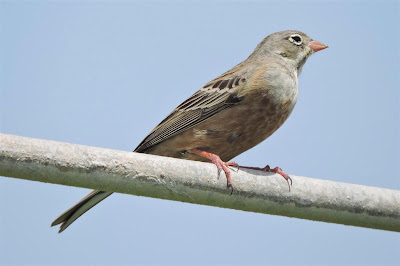For seven months of the year to extend birding beyond 11am, there is only two strategies that work in the Middle East. The first is to find yourself at 2,500 metres or higher such as in Abha, Saudi Arabia or Jebel Akhdar, Oman.
The second is to find shade or be in an air-conditioned car next to water and watch the birds come to you. This also requires you have plenty of drinking water too.
At Qatbeet I hide myself in some shaded bushes next to a pool and waited. I waited for nearly two hours in total. I knew the light in front of was either dappled or very strong but there was no choice.
After a few minutes I heard a crashing noise in the bushes next to me. I thought a cat had appeared. However when I looked hard at where the noise had come from, I found a European nightjar had landed two metres away from me and promptly fallen asleep.
European nightjar lengthways
first view of European nightjar
When it first appeared my view was front ways on as in the picture above.
Having satisfied myself with better views I returned to my hide and continued waiting. All the time the European nightjar stayed without moving.
house sparrow
House sparrow were the most frequent visitors to water probably because there are more of them than other birds.
rufous bush robin
Rufous bush robin were once again around. This bird is extremely common on passage.
willow warbler
However it was the warblers which held most of my attention. Willow warbler was everywhere around the bushes. Eastern olivaceous warbler was nearly as numerous but tended to be higher in trees. A female blackcap was a frequent visitor to the tallest tree.
lesser whitethroat
I struggled with the light throughout while trying to take pictures. This lesser whitethroat was very close but backlighting made a picture extremely difficult.
masked shrike
Other species diverted my attention away from the warblers from time to time. One time was when a masked shrike appeared on the scene. The dappling sunlight initially obscured the view.
masked shrike
Similarly one of the spotted flycatcher on site perched near the water for a while. It was in a dark patch and caused a different type of photographic problem.
spotted flycatcher
A male and a female common redstart also evaded my camera.
male blackcap
Though the female blackcap did the same, I did manage a record shot of a male blackcap.
By 2.30pm I could take the heat no longer and I walked back towards the car. I picked up a pied wheatear and northern wheatear on the way before seeing a barred warbler right next to the car. Not all the birds had gone to drink it seems.





























































